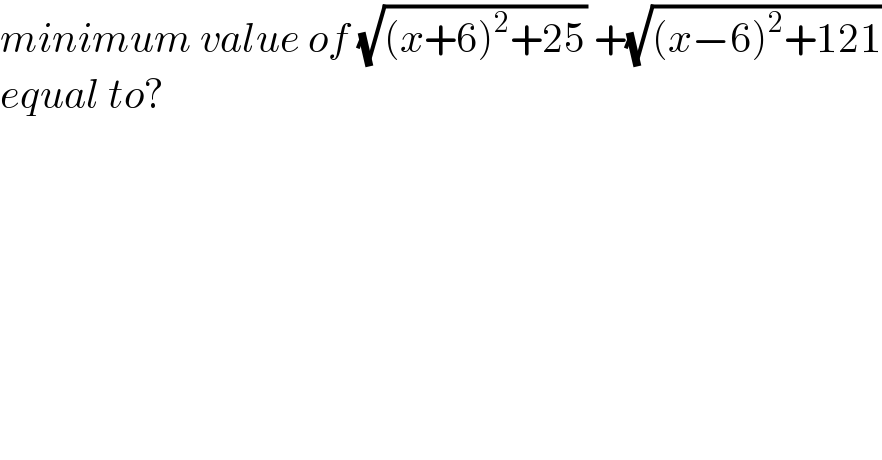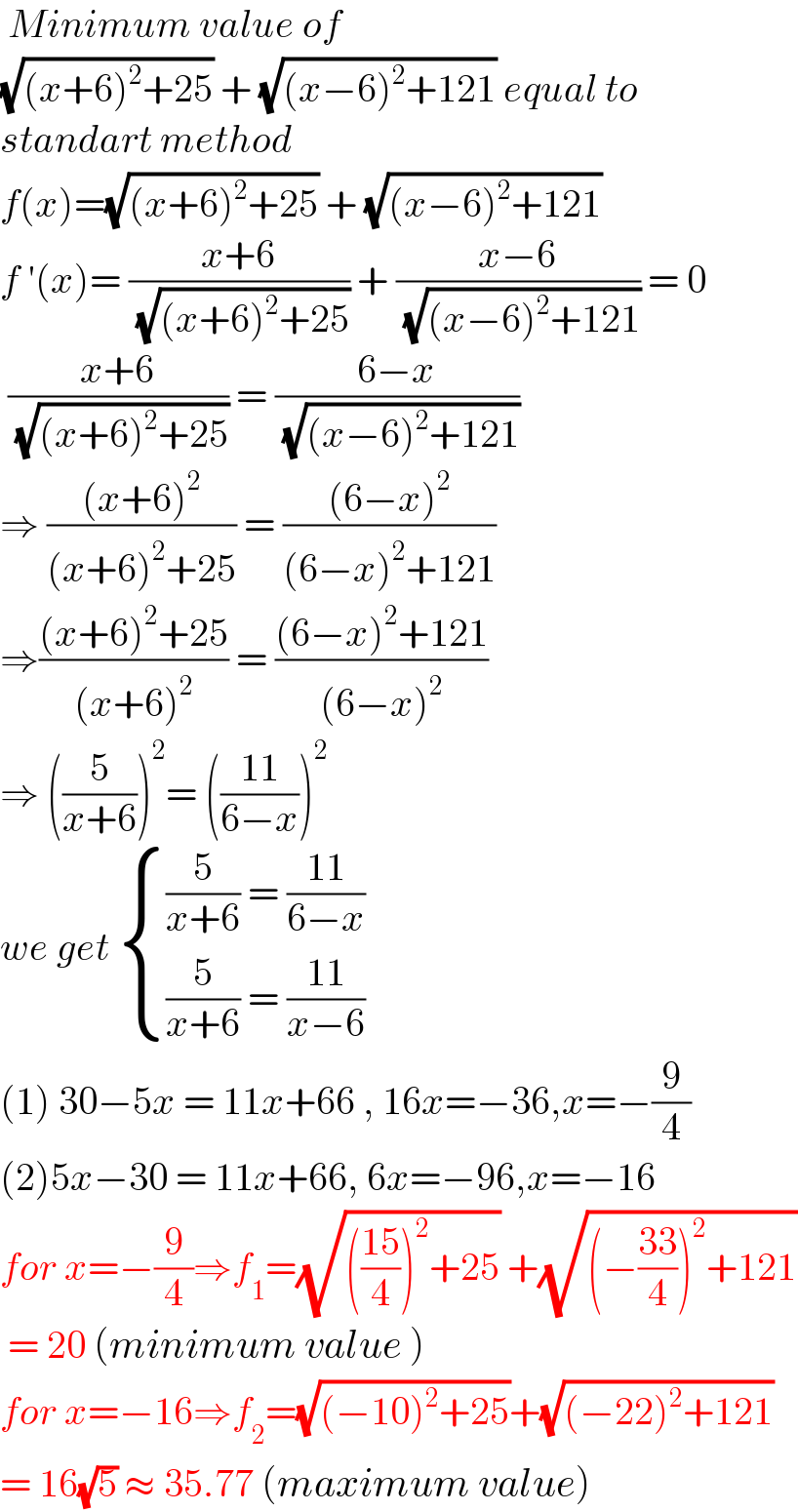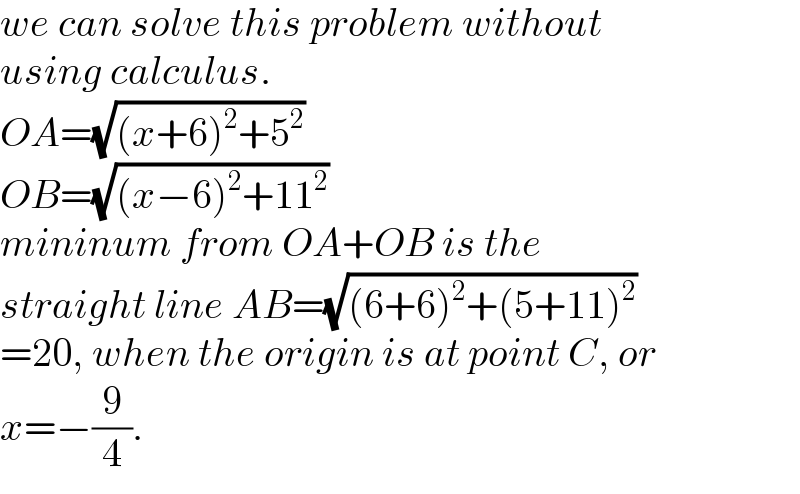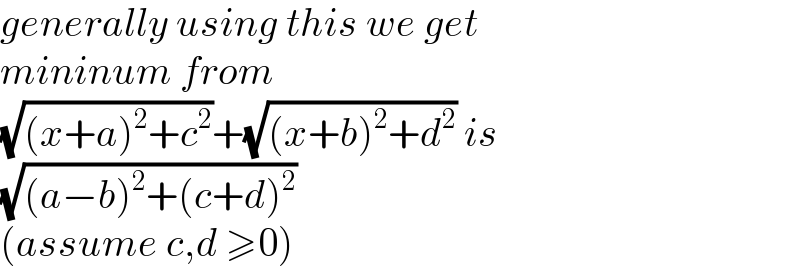
Question Number 135925 by liberty last updated on 17/Mar/21

$${minimum}\:{value}\:{of}\:\sqrt{\left({x}+\mathrm{6}\right)^{\mathrm{2}} +\mathrm{25}}\:+\sqrt{\left({x}−\mathrm{6}\right)^{\mathrm{2}} +\mathrm{121}} \\ $$$${equal}\:{to}? \\ $$
Answered by john_santu last updated on 17/Mar/21

$$\:{Minimum}\:{value}\:{of}\: \\ $$$$\sqrt{\left({x}+\mathrm{6}\right)^{\mathrm{2}} +\mathrm{25}}\:+\:\sqrt{\left({x}−\mathrm{6}\right)^{\mathrm{2}} +\mathrm{121}}\:{equal}\:{to} \\ $$$${standart}\:{method} \\ $$$${f}\left({x}\right)=\sqrt{\left({x}+\mathrm{6}\right)^{\mathrm{2}} +\mathrm{25}}\:+\:\sqrt{\left({x}−\mathrm{6}\right)^{\mathrm{2}} +\mathrm{121}} \\ $$$${f}\:'\left({x}\right)=\:\frac{{x}+\mathrm{6}}{\:\sqrt{\left({x}+\mathrm{6}\right)^{\mathrm{2}} +\mathrm{25}}}\:+\:\frac{{x}−\mathrm{6}}{\:\sqrt{\left({x}−\mathrm{6}\right)^{\mathrm{2}} +\mathrm{121}}}\:=\:\mathrm{0} \\ $$$$\:\frac{{x}+\mathrm{6}}{\:\sqrt{\left({x}+\mathrm{6}\right)^{\mathrm{2}} +\mathrm{25}}}\:=\:\frac{\mathrm{6}−{x}}{\:\sqrt{\left({x}−\mathrm{6}\right)^{\mathrm{2}} +\mathrm{121}}} \\ $$$$\Rightarrow\:\frac{\left({x}+\mathrm{6}\right)^{\mathrm{2}} }{\left({x}+\mathrm{6}\right)^{\mathrm{2}} +\mathrm{25}}\:=\:\frac{\left(\mathrm{6}−{x}\right)^{\mathrm{2}} }{\left(\mathrm{6}−{x}\right)^{\mathrm{2}} +\mathrm{121}} \\ $$$$\Rightarrow\frac{\left({x}+\mathrm{6}\right)^{\mathrm{2}} +\mathrm{25}}{\left({x}+\mathrm{6}\right)^{\mathrm{2}} }\:=\:\frac{\left(\mathrm{6}−{x}\right)^{\mathrm{2}} +\mathrm{121}}{\left(\mathrm{6}−{x}\right)^{\mathrm{2}} } \\ $$$$\Rightarrow\:\left(\frac{\mathrm{5}}{{x}+\mathrm{6}}\right)^{\mathrm{2}} =\:\left(\frac{\mathrm{11}}{\mathrm{6}−{x}}\right)^{\mathrm{2}} \\ $$$${we}\:{get}\:\begin{cases}{\frac{\mathrm{5}}{{x}+\mathrm{6}}\:=\:\frac{\mathrm{11}}{\mathrm{6}−{x}}}\\{\frac{\mathrm{5}}{{x}+\mathrm{6}}\:=\:\frac{\mathrm{11}}{{x}−\mathrm{6}}}\end{cases} \\ $$$$\left(\mathrm{1}\right)\:\mathrm{30}−\mathrm{5}{x}\:=\:\mathrm{11}{x}+\mathrm{66}\:,\:\mathrm{16}{x}=−\mathrm{36},{x}=−\frac{\mathrm{9}}{\mathrm{4}} \\ $$$$\left(\mathrm{2}\right)\mathrm{5}{x}−\mathrm{30}\:=\:\mathrm{11}{x}+\mathrm{66},\:\mathrm{6}{x}=−\mathrm{96},{x}=−\mathrm{16} \\ $$$${for}\:{x}=−\frac{\mathrm{9}}{\mathrm{4}}\Rightarrow{f}_{\mathrm{1}} =\sqrt{\left(\frac{\mathrm{15}}{\mathrm{4}}\right)^{\mathrm{2}} +\mathrm{25}}\:+\sqrt{\left(−\frac{\mathrm{33}}{\mathrm{4}}\right)^{\mathrm{2}} +\mathrm{121}} \\ $$$$\:=\:\mathrm{20}\:\left({minimum}\:{value}\:\right) \\ $$$${for}\:{x}=−\mathrm{16}\Rightarrow{f}_{\mathrm{2}} =\sqrt{\left(−\mathrm{10}\right)^{\mathrm{2}} +\mathrm{25}}+\sqrt{\left(−\mathrm{22}\right)^{\mathrm{2}} +\mathrm{121}} \\ $$$$=\:\mathrm{16}\sqrt{\mathrm{5}}\:\approx\:\mathrm{35}.\mathrm{77}\:\left({maximum}\:{value}\right) \\ $$
Commented by mr W last updated on 17/Mar/21

$${maximum}\:{doesn}'{t}\:{exist},\:{since} \\ $$$$\underset{{x}\rightarrow−\infty} {\mathrm{lim}}{f}\left({x}\right)=+\infty \\ $$$$\underset{{x}\rightarrow+\infty} {\mathrm{lim}}{f}\left({x}\right)=+\infty \\ $$
Answered by mr W last updated on 17/Mar/21

Commented by mr W last updated on 17/Mar/21

$${we}\:{can}\:{solve}\:{this}\:{problem}\:{without} \\ $$$${using}\:{calculus}. \\ $$$${OA}=\sqrt{\left({x}+\mathrm{6}\right)^{\mathrm{2}} +\mathrm{5}^{\mathrm{2}} } \\ $$$${OB}=\sqrt{\left({x}−\mathrm{6}\right)^{\mathrm{2}} +\mathrm{11}^{\mathrm{2}} } \\ $$$${mininum}\:{from}\:{OA}+{OB}\:{is}\:{the} \\ $$$${straight}\:{line}\:{AB}=\sqrt{\left(\mathrm{6}+\mathrm{6}\right)^{\mathrm{2}} +\left(\mathrm{5}+\mathrm{11}\right)^{\mathrm{2}} } \\ $$$$=\mathrm{20},\:{when}\:{the}\:{origin}\:{is}\:{at}\:{point}\:{C},\:{or} \\ $$$${x}=−\frac{\mathrm{9}}{\mathrm{4}}. \\ $$
Commented by mr W last updated on 17/Mar/21

$${generally}\:{using}\:{this}\:{we}\:{get} \\ $$$${mininum}\:{from} \\ $$$$\sqrt{\left({x}+{a}\right)^{\mathrm{2}} +{c}^{\mathrm{2}} }+\sqrt{\left({x}+{b}\right)^{\mathrm{2}} +{d}^{\mathrm{2}} }\:{is} \\ $$$$\sqrt{\left({a}−{b}\right)^{\mathrm{2}} +\left({c}+{d}\right)^{\mathrm{2}} } \\ $$$$\left({assume}\:{c},{d}\:\geqslant\mathrm{0}\right) \\ $$
Commented by liberty last updated on 17/Mar/21

$${waw}...{it}\:{follows}\:{that}\:{if} \\ $$$$\sqrt{\left({x}+\mathrm{3}\right)^{\mathrm{2}} +\mathrm{36}}\:+\:\sqrt{\left({x}−\mathrm{3}\right)^{\mathrm{2}} +\mathrm{49}} \\ $$$${the}\:{method}\:{valid}\:{sir}? \\ $$
Commented by mr W last updated on 17/Mar/21
![yes. an other example: [(√((x+3)^2 +10)) + (√((x+8)^2 +20))]_(min) =(√((8−3)^2 +((√(10))+(√(20)))^2 ))=(√(55+20(√2))) you can check it with Grapher or using calculus.](Q135970.png)
$${yes}. \\ $$$${an}\:{other}\:{example}: \\ $$$$\left[\sqrt{\left({x}+\mathrm{3}\right)^{\mathrm{2}} +\mathrm{10}}\:+\:\sqrt{\left({x}+\mathrm{8}\right)^{\mathrm{2}} +\mathrm{20}}\right]_{{min}} \\ $$$$=\sqrt{\left(\mathrm{8}−\mathrm{3}\right)^{\mathrm{2}} +\left(\sqrt{\mathrm{10}}+\sqrt{\mathrm{20}}\right)^{\mathrm{2}} }=\sqrt{\mathrm{55}+\mathrm{20}\sqrt{\mathrm{2}}} \\ $$$${you}\:{can}\:{check}\:{it}\:{with}\:{Grapher}\:{or} \\ $$$${using}\:{calculus}. \\ $$
Commented by liberty last updated on 17/Mar/21

$${great}.... \\ $$
Commented by Dwaipayan Shikari last updated on 17/Mar/21

$${Newton}\:{used}\:{to}\:{have}\:{Geometrical}\:{Method}\:{of}\:{Calculus} \\ $$
